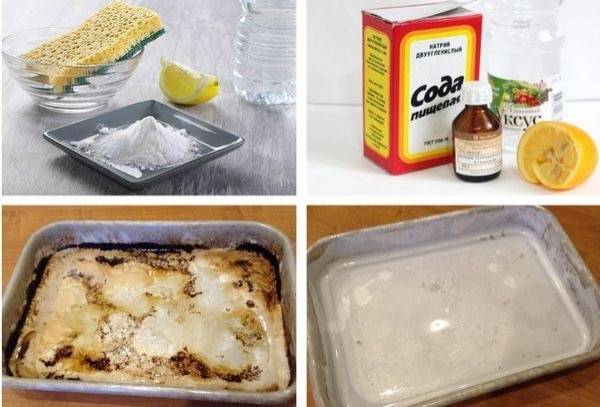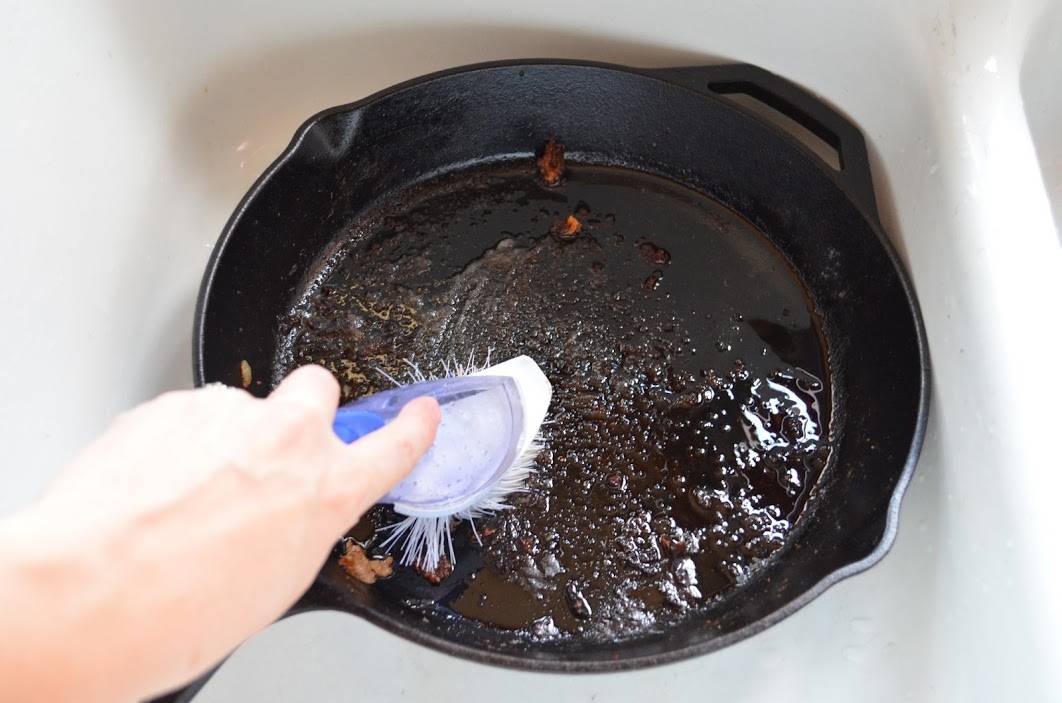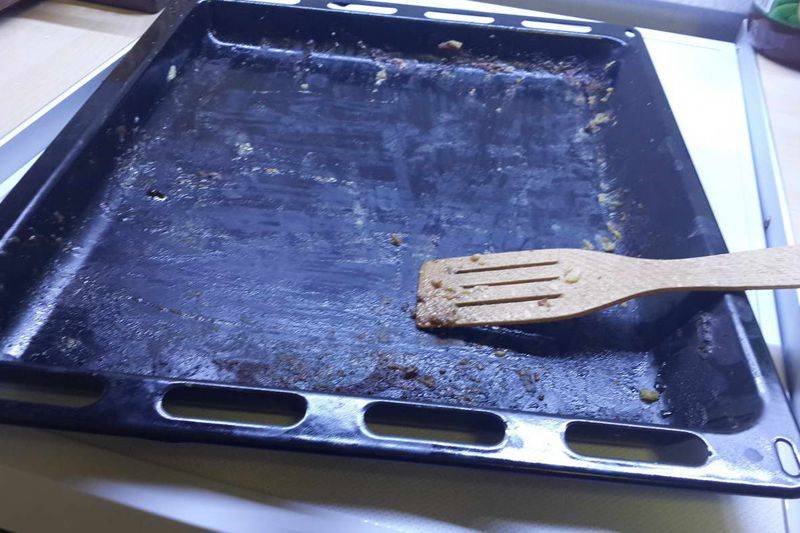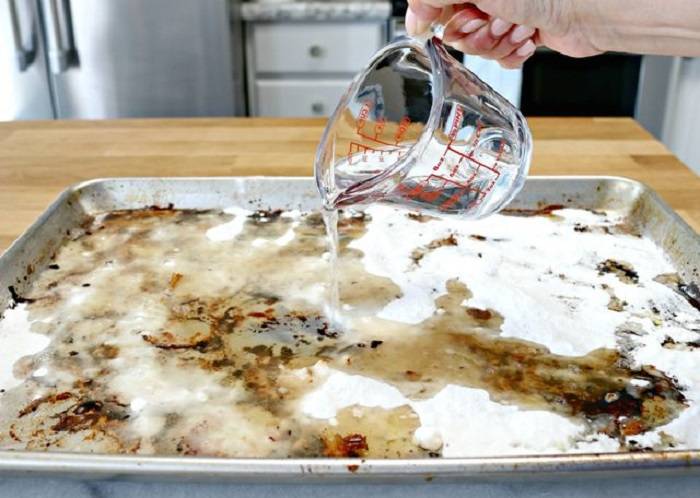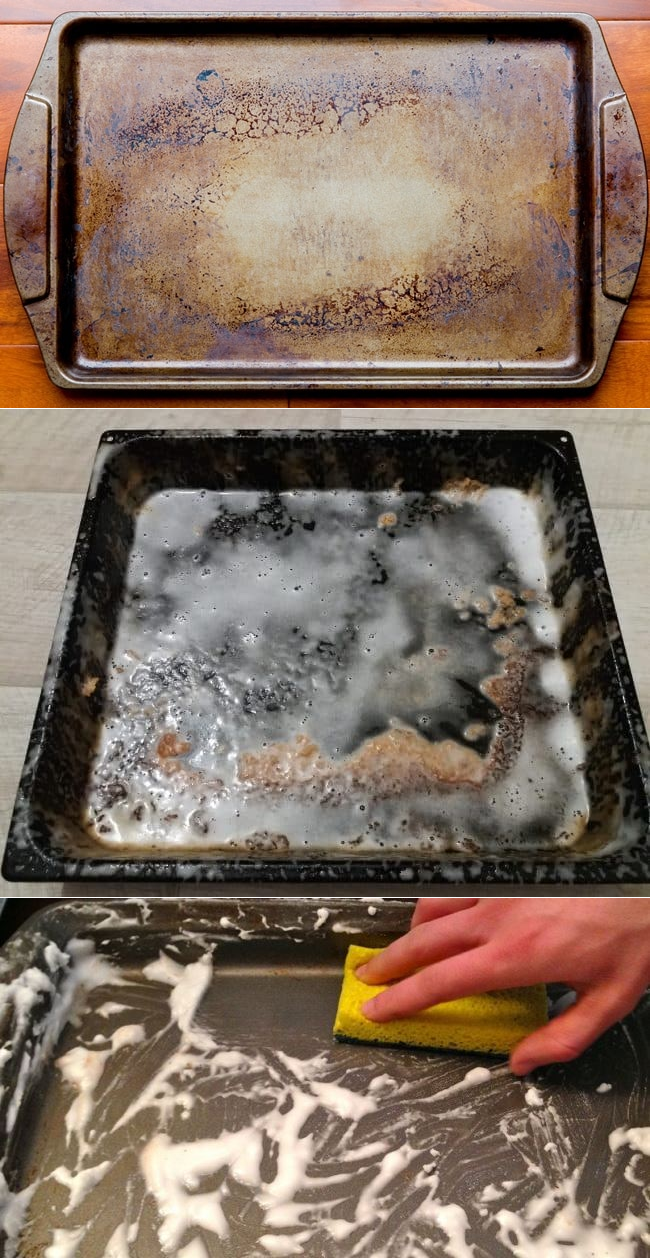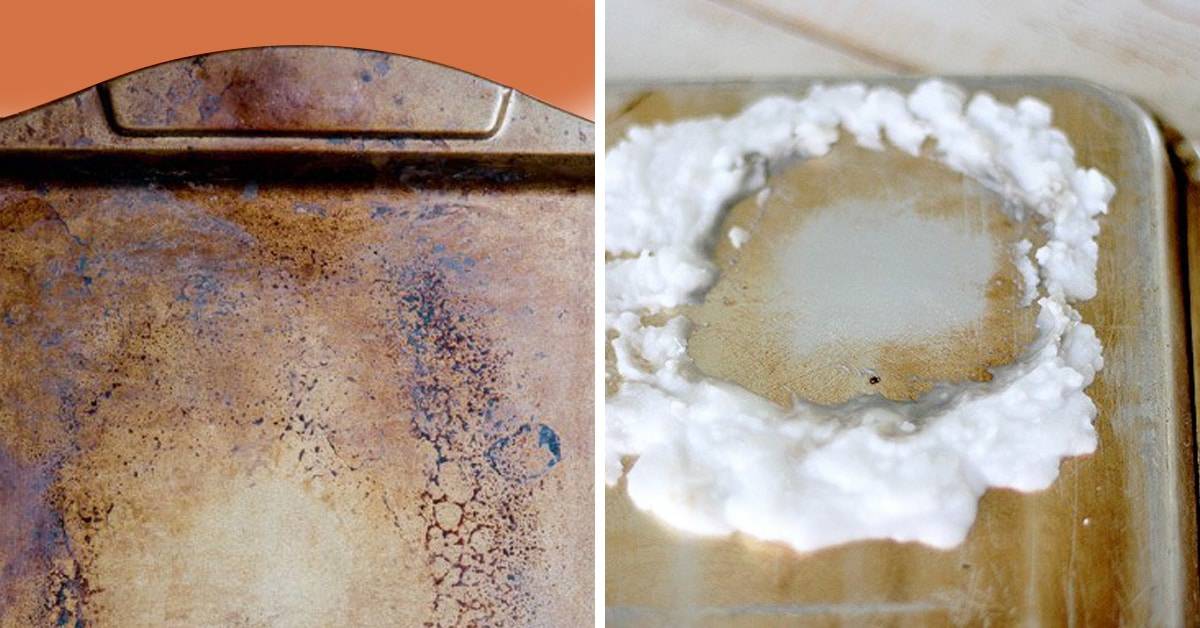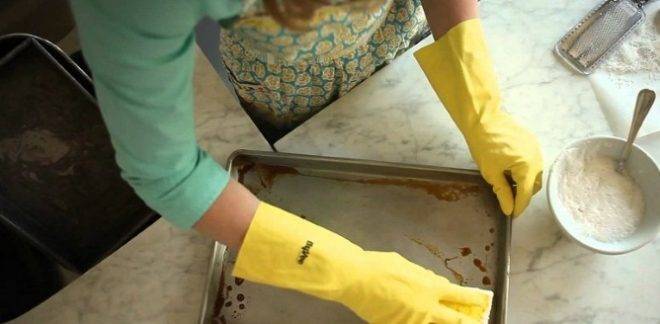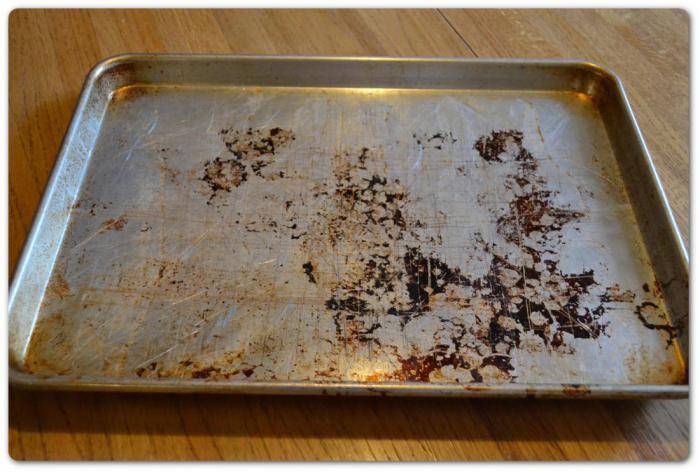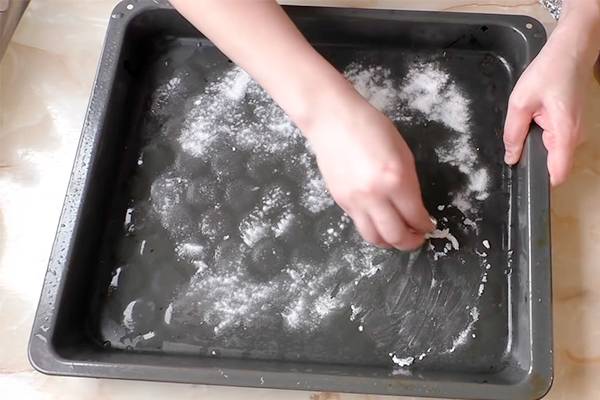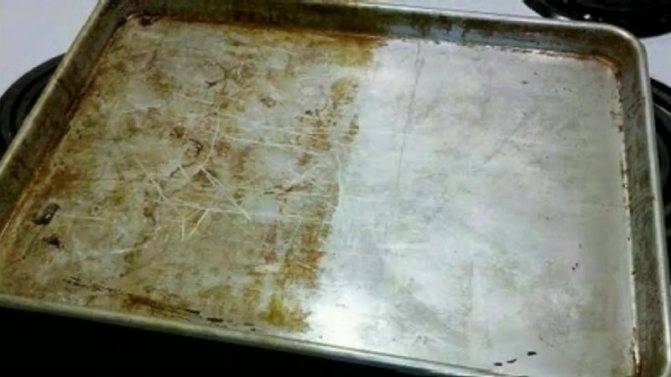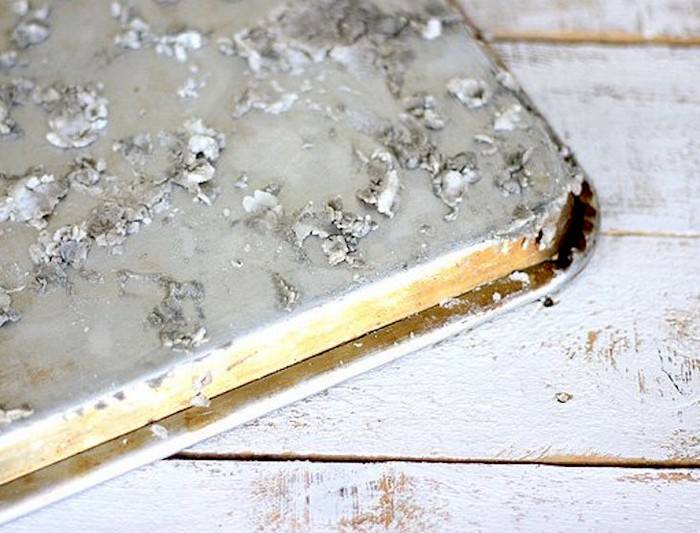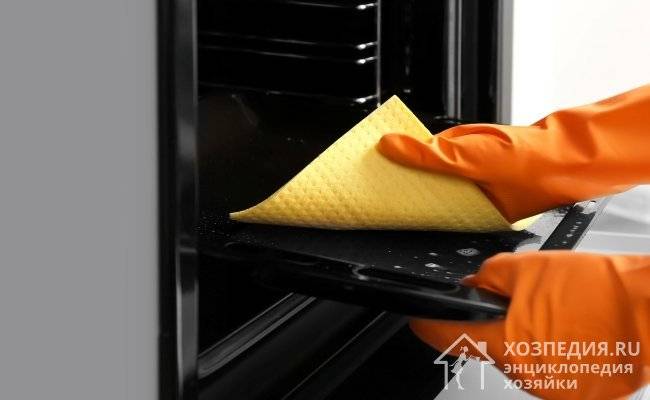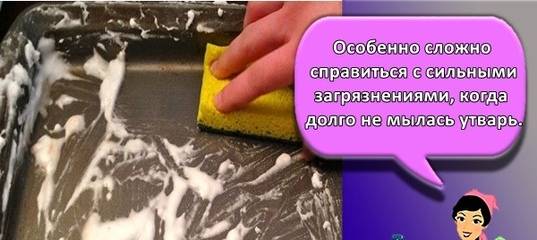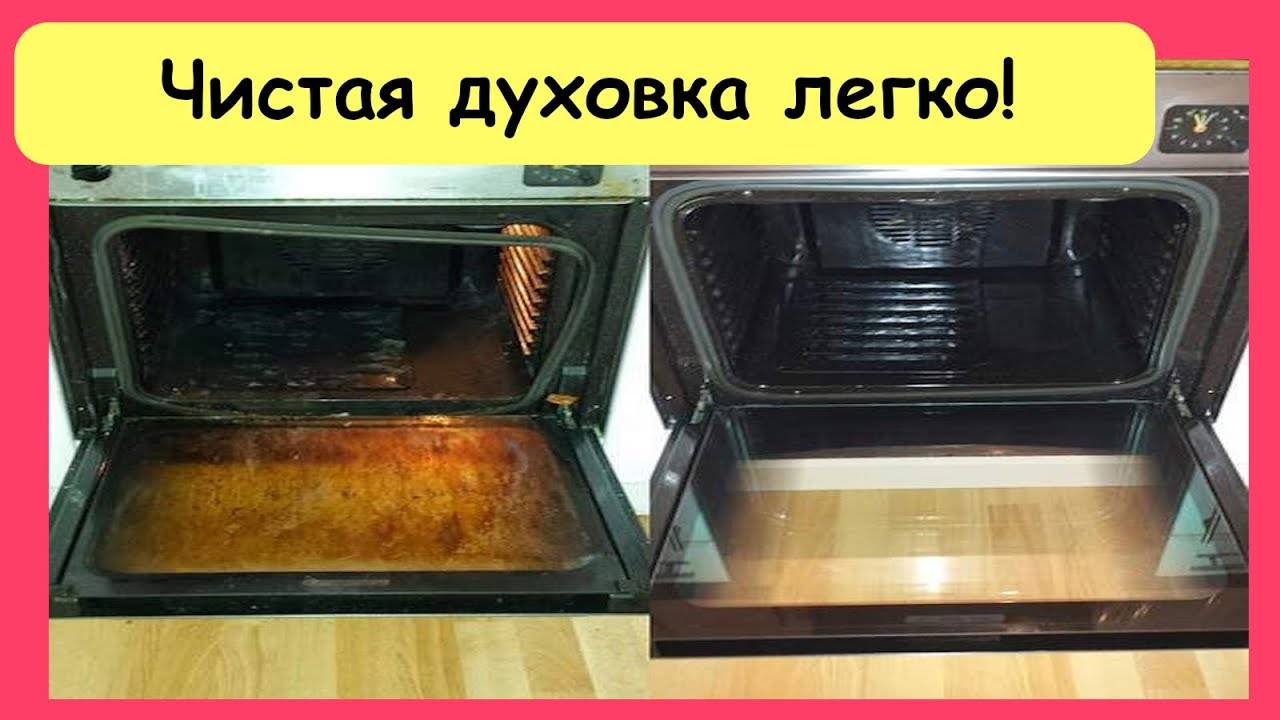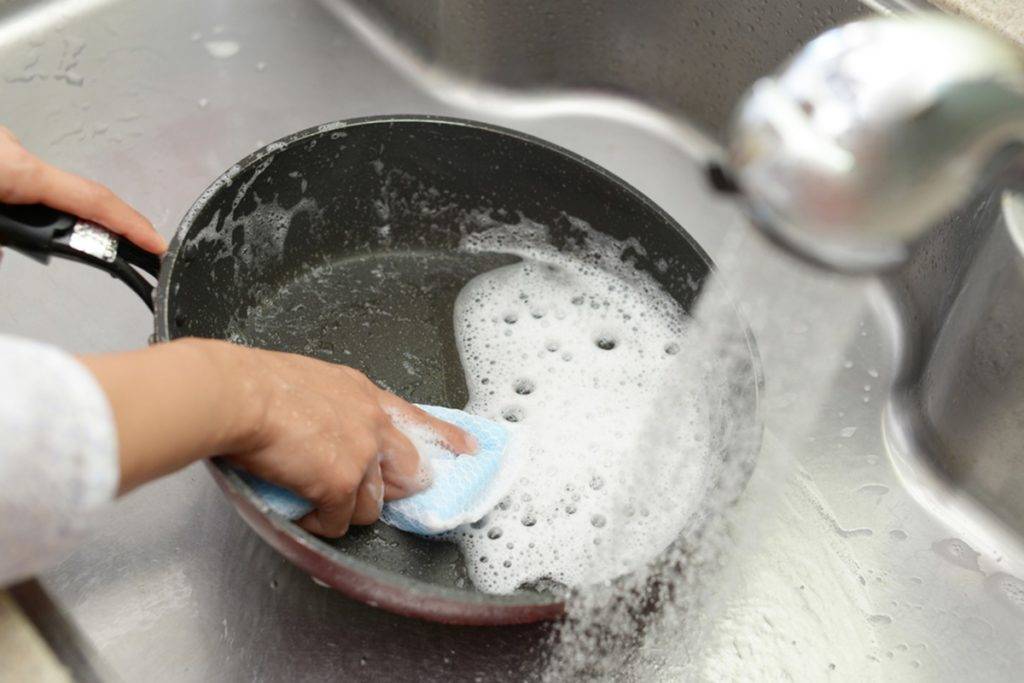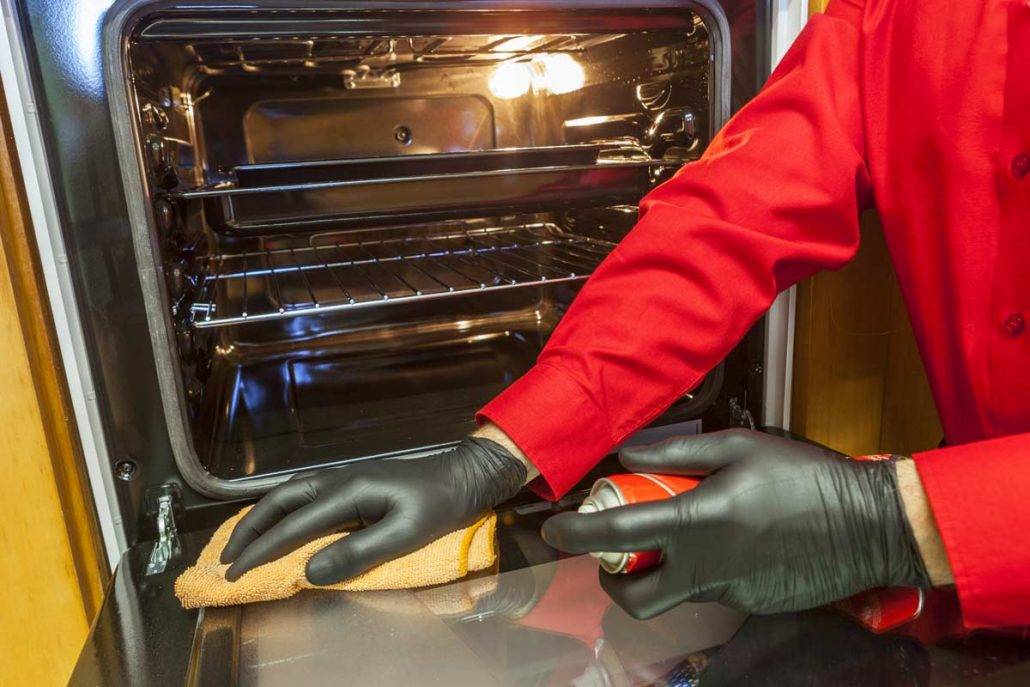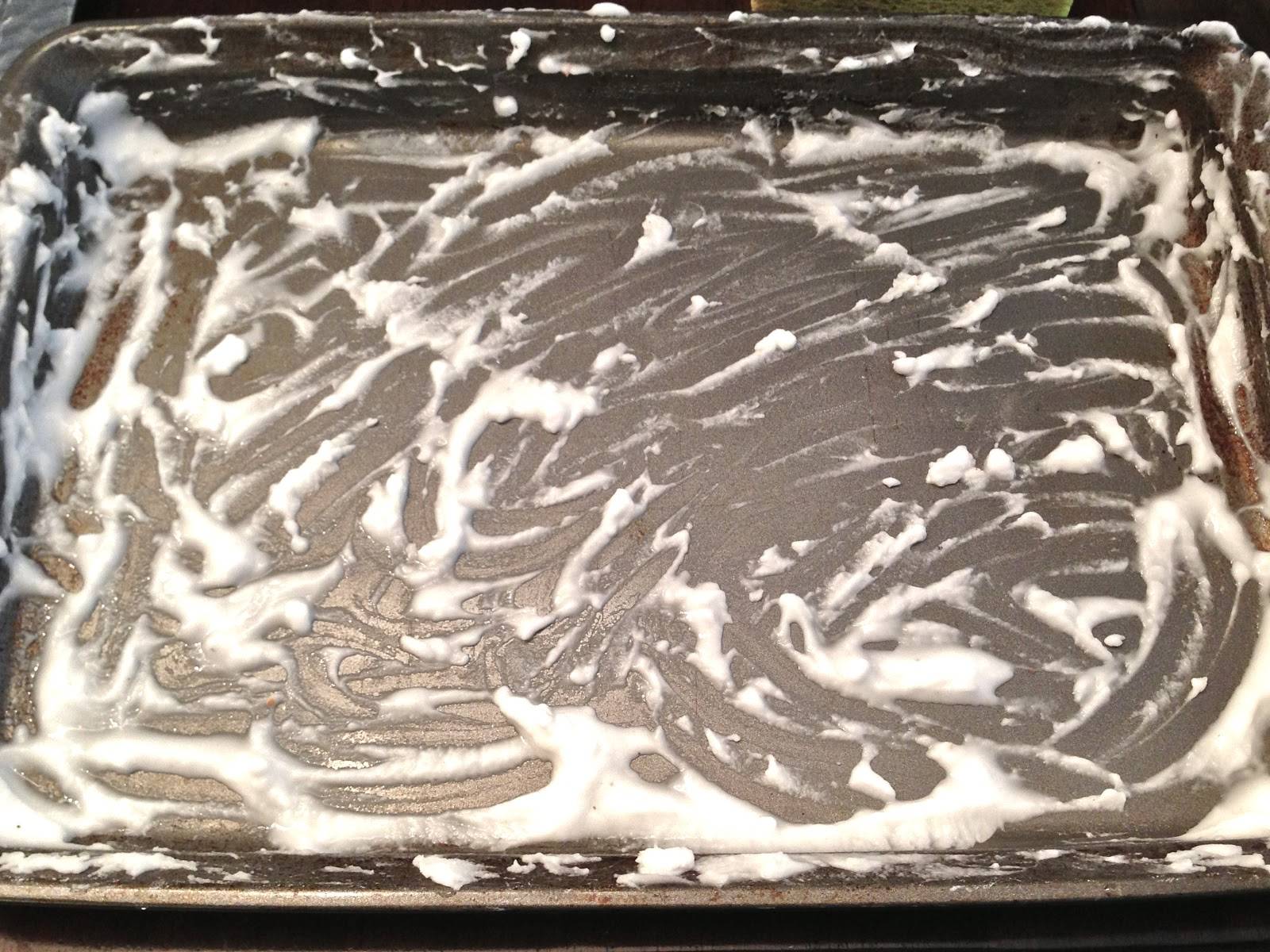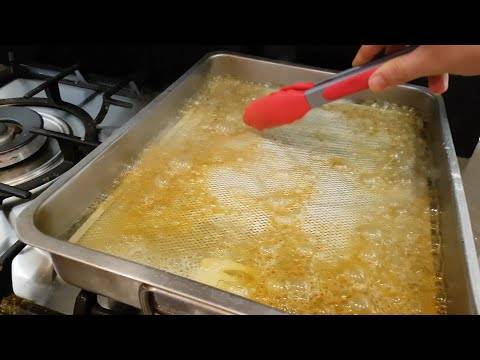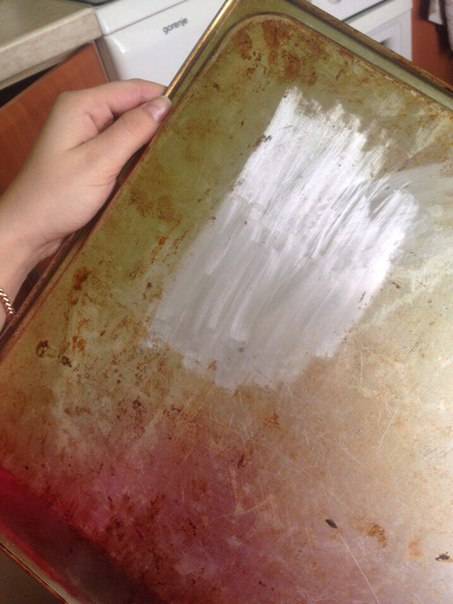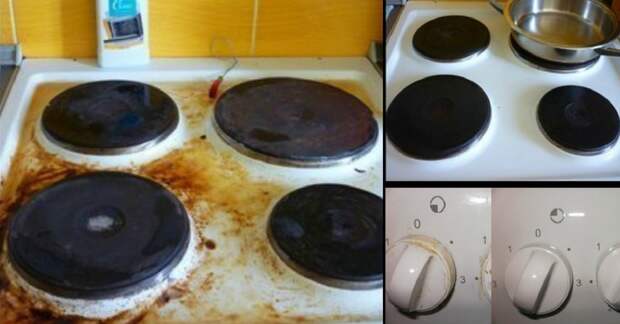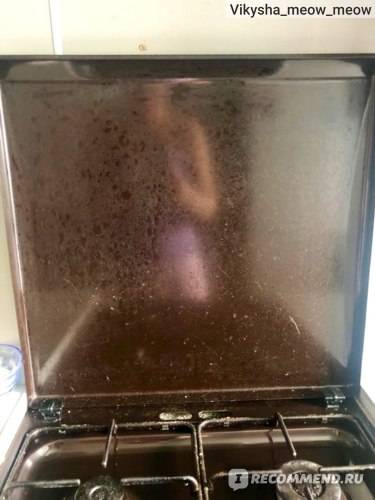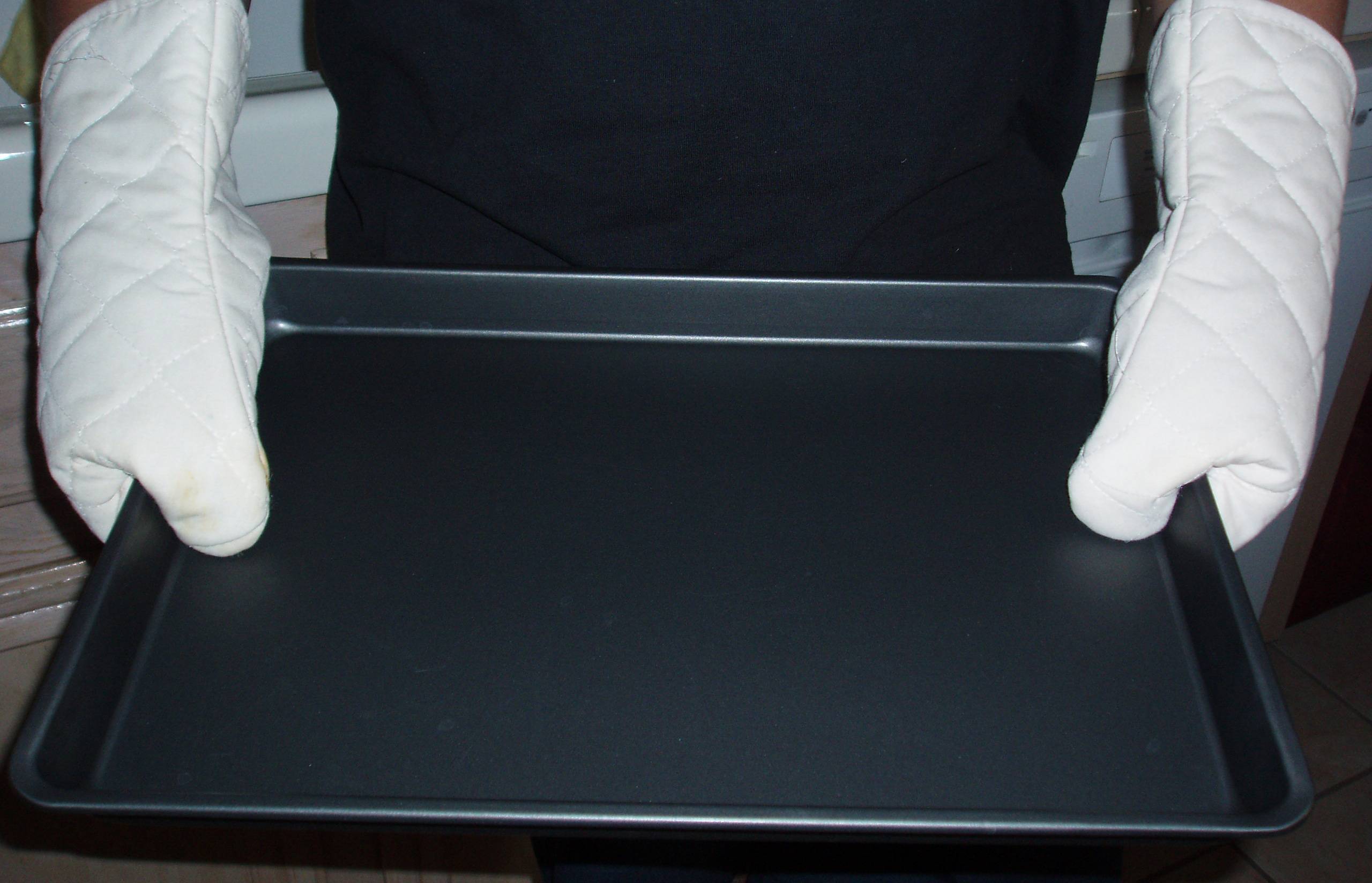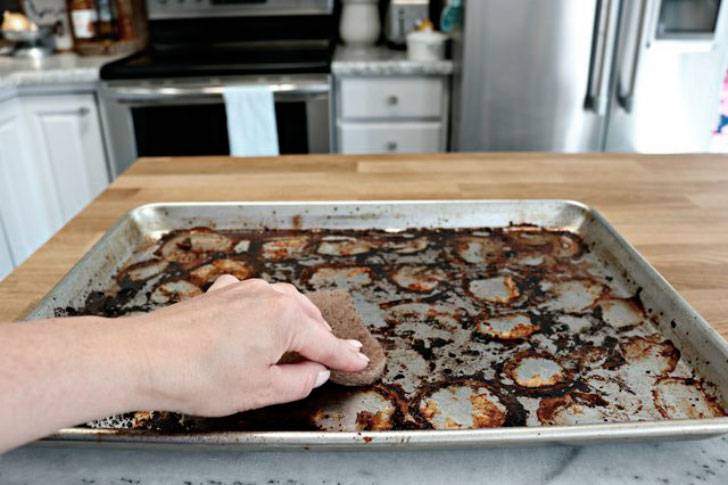Methods for cleaning the baking sheet from fat and carbon deposits
If folk remedies have not helped completely and without a trace to wash off the greasy carbon deposits on the surface of the baking sheet, you will have to connect other, more intense exposure options.
- Exposure to high temperatures. To clean the product from a very dense and old layer of fat, you need to carry out its complex processing. We place the baking sheet in the oven, fill its bottom with water, in which a little soda, vinegar or dish detergent is diluted. We turn on the heating, close the oven and wait a few minutes. The liquid must not be allowed to completely evaporate! After such preparation, you can easily wash off any carbon deposits.
- Using the self-cleaning function. Some modern household appliances have a self-cleaning camera system. Do not neglect it, it is a rather gentle, but very effective method. In the process of manipulation, it is necessary to ventilate the room, otherwise it may fill with a heavy, difficult to remove odor.
- The use of special tools. This technique is always used last, because no one is immune from the harmful effects of chemicals.
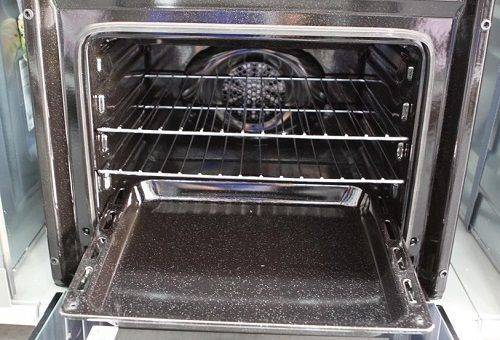
When working with specialized tools, you need to adhere to certain rules:
- First, the baking sheet must be mechanically cleaned from dirt deposits. This is done using a spatula to scrape off the dirt and a sheet of paper to remove the collected material.
- Next, distribute the selected substance evenly or spray it on the surface, leave it for a quarter of an hour. Sometimes manufacturers recommend adding a little water.
- After the specified time, wipe the surface with a washcloth, sponge or napkin.
- Finally, we rinse the product with clean water and dry thoroughly. After such processing, the item is returned to the oven and, if necessary, dried with warm air.

When choosing the best options for cleaning the baking sheet, it is necessary to adhere to environmentally friendly preparations, minimizing the use of aggressive solvents and reagents. Sometimes it is better to replace a spoiled baking sheet in time than to treat it with acid, and then cook food in the created environment.
Plaque on the baking sheet will accumulate more slowly if, after using the item, it is not only washed, but also wiped thoroughly. Often, fat residues remain on water droplets and settle after they dry.
Safe chemistry for cleaning the baking sheet
Professional products are able to remove food residues, grease stains, corrosion, carbon deposits. Before buying them, it is recommended that you read the instructions carefully. It is necessary to choose a mixture for exactly your type of dish. Some drugs are left on the surface and wait for them to take effect, others are used as cleaning solutions.
There are concentrated, gel-like products, powders. To make it easier to work, the bottles are supplied with a special spray bottle.
Recommended preparations for removing soot from kitchen utensils:
- Liquid concentrated solution for the Amway oven. Perfectly cleans cabinet walls, baking trays from all surfaces, even glass and Teflon. Together with the solution, a brush with a nozzle for washing containers is provided.
- "Shine" is a budgetary gel made in Russia. Can be applied to any kitchen utensil. The thick mixture shows results after 25 minutes. After achieving the expected effect, the surface is simply washed with water from a tap with a sponge.
- Professional chemical line "CleanUp" with a spray bottle. The product is applied sparingly and is easy to use.Helps to remove burnt grease, food, stains, carbon deposits. It can be used to clean the oven, any metal products.
- Shumanit does an excellent job with problem areas, but the remedy is quite aggressive.
- Chister is an economical, mild drug. It can be used to wipe off non-stick coatings. It has the disadvantage that it does not always bring an excellent effect.
Some preparations are intended only for application, you cannot rub the coating with them. If you use them strictly according to the instructions, you can achieve a quick and safe disposal of the baking sheet from soot and other stains.
How to clean a stainless steel baking sheet
It is not recommended to clean stainless steel dishes and baking sheets with abrasive substances, metal scouring pads, otherwise the coating of the baking sheet or pan may be scratched. If the baking sheet has not been washed after processing the sponge with dish detergent, cover the surface with ordinary baking soda, diluting it with warm water to a gruel state. Leave in this form for 1-2 hours. Then clean with a regular dish sponge and wipe dry.
Stainless steel baking sheet.
Baking powder works the same way as baking soda, so the following rule applies:
- remove the remnants of the finished dish from the contaminated surface;
- wash the baking sheet with hot water and a small amount of a special product;
- pour a baking powder for the dough on the bottom, soaking it with water;
- leave for 30 minutes, rinse with water;
- wipe the surface dry.
Aluminum kitchen utensils are not afraid to remove dirt with fine powders and hard metal brushes. All of the following applies to the aluminum baking sheet. How to quickly remove burnt fat from the surface:
- remove the remnants of ready-made dishes;
- soak a baking sheet in hot water with the addition of dishwashing liquid;
- rinse with water;
- sprinkle soda or salt on the bottom, rub with a sponge;
- if it is not possible to remove carbon deposits, then use a metal brush.
Aluminum baking sheet.
How do I clean old fat from a baking sheet? In many cases, only baking soda and mustard powder will help to deal with greasy dishes. At home, you can wash baking sheets with these products:
- sprinkle soda or mustard powder on the contaminated surface;
- pour hot water and leave to soak for several hours;
- additionally treat the surface with dishwashing gel and dry with a towel.
Folk remedies that can be used to combat contaminated surfaces are soda and salt. For this you need:
- prepare a mixture: 3/4 cup baking soda, ¼ cup salt and water, stir;
- process the bottom of the baking sheet with this mass overnight;
- in the morning, remove dirt with a dishwashing detergent;
- wipe the entire surface dry.
If the baking trays are heavily soiled with fat, you can use boiling. When a woman washes surfaces in this way, it is worth considering some subtleties:
- put the baking sheet in a volumetric container;
- pour water to completely cover the surface to be cleaned;
- add two tablespoons of dishwashing liquid and baking soda;
- boil the dishes for half an hour;
- to achieve a positive result, add a spoonful of "Anti-Fat";
- when the baking sheet is cool, rinse with water.
Do not remove the hot baking sheet from the water so that the surface does not burst. Better to wait until it cools down.
Baking trays with glass, ceramic and enamel surfaces are dishwasher-safe. To wash them well, you should set the temperature program, as for pots at 65 degrees.
You can wash the surface from carbon deposits by a simple method:
- pour water, a small amount of soda and vinegar into a baking sheet;
- put in an oven preheated to 100 degrees for 20 minutes;
- cool and rinse, glass surfaces lend themselves particularly well to such cleaning.
Annealing with salt
A tried and tested method based on exposure to high temperatures can be used to clean the baking sheet. Fat Removal Stages:
- salt is poured onto the bottom of the baking sheet with a layer of at least 0.5 cm;
- it is put in an oven preheated to 100 degrees;
- when the salt turns brown, the baking sheet is removed from the oven;
- rinse with water using a sponge.
For such processing, you can use dishes (saucepan, basin, boil), which is much larger than the baking sheet in size.
The process takes place in several stages:
- pour enough water into a large saucepan so that the baking sheet is completely covered with it;
- add preparations: 2 tablespoons of dishwashing gel and the same amount of soda;
- put on fire and boil for half an hour;
- wash under running water;
- remove the remaining greasy spots with a hard sponge.
Gentle cleaning
This method is ideal for cleaning silicone and Teflon trays. In addition, this way you can tidy up products made from other materials, if they have minor contamination. An ordinary detergent, which can be purchased at any store, will help you. There is only one condition: it should not contain alkali and abrasive particles, because they can damage the product.
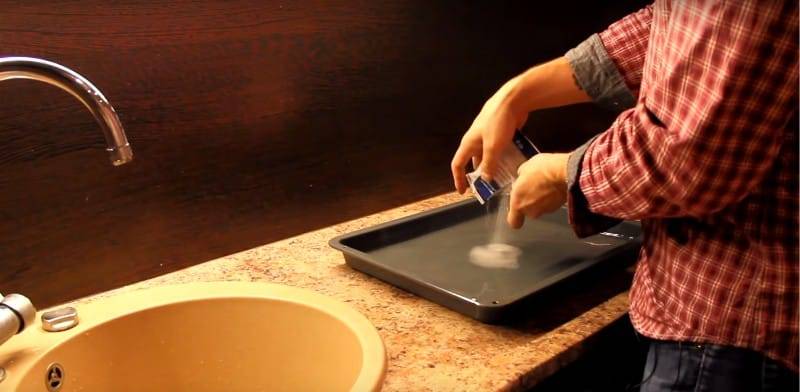
It is much more difficult to remove fat from a Teflon baking sheet. Try the following way:
Equip yourself with a spatula and scrape off any particles that come off the surface easily enough.
Take salt and sprinkle it on the wet bottom
The salt layer should reach about 0.5-0.6 cm.
Wait half an hour.
Now, very carefully, wash off all the salt. Just do it carefully so as not to accidentally scratch the coating.
Remove carbon deposits again with a spatula.
Take a sponge and detergent and then rinse the baking sheet thoroughly.

Cleaning with folk remedies
These recipes have been tested over the years and sometimes turn out to be more useful and effective than household chemicals. In addition, they have the advantage - there is no risk of contaminants entering food, as when using store products. The following products and products that are in every home will help clear old carbon deposits from the baking sheet:
- lemon acid;
- glue;
- salt or soda;
- acetic acid;
- butter;
- powder.
Soda and salt
 The handy tools found in every kitchen, such as baking soda and salt, help to deal with dirt.
The handy tools found in every kitchen, such as baking soda and salt, help to deal with dirt.
These products act as abrasive materials. To clean the baking sheet outside and inside, boil it in a large container with baking soda or salt. Small contaminants are cleaned with sodium carbonate with a sponge. Fresh carbon deposits will remove a homemade product from 100 g of baking soda, detergent and peroxide in a ratio of 1 tsp: 1 tbsp. l. The mixture is applied to dirt and after 15 minutes rubbed with a hard washcloth.
Lemon acid
It is poured into a container of water and boiled for 15-20 minutes. This method removes plaque well inside the baking sheet. To cleanse it from the outside, it is immersed in a large container. After boiling, all that remains is to wash the surface and remove carbon residues with a cleaning agent. The use of citric acid is suitable for aluminum and stainless steel cookware.
Soap and glue
This recipe is suitable for cleaning enamelled surfaces and stainless steel cookware. Half a bar of dark laundry soap is crushed on a fine grater, mixed with 4 liters of water and a tablespoon of PVA stationery glue. The composition is poured onto a baking sheet, put on fire, brought to a boil and kept for 30 minutes, then washed off. As a result, scale is washed away and the surface remains clean.
Using vinegar
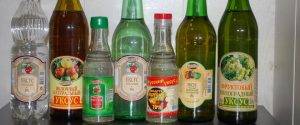 Vinegar is acceptable for aluminum baking trays as it will thin the enamel.
Vinegar is acceptable for aluminum baking trays as it will thin the enamel.
The principle of use is simple: table vinegar is poured into a baking sheet and left for several hours. To remove fresh carbon deposits from the outside of the vessel, use a less concentrated solution, diluting it with water in a 1: 1 ratio. Such a liquid is used to wipe the remains of fat that has not been removed. But this method thinns the enamel, so it is only suitable for aluminum baking sheets.
Boiling
To clean the baking sheet in this way, you need to pour water into it. Its amount should be such that it completely covers the dirt. Then add a little dish detergent, vinegar and soda there and put in a hot oven. Keep the solution boiling for at least 20 minutes, after which the dishes are taken out, the water is poured and cleaned of carbon deposits in a convenient way.
Washing powder and oil
Suitable for all types of surfaces including enamels and Teflon. This recipe helps clean grooved surfaces on grill or baking trays. A mixture is made from the required amount of water, 3 tablespoons of oil and 1 tbsp. l. powder. Contaminated dishes are immersed in this solution, boiled for 10-15 minutes, left to infuse overnight, then cleaned.
Other methods
Cleansing with folk remedies is more effective when combining several methods. It is recommended to tear off carbon residues with a stiff brush, if the surface allows it. Sand or coffee grounds, which act like sandpaper, can help replace the brush. You can try to cover the carbon with Coca-Cola, which will eat away at the dirt. Ammonia does a good job, with which they wipe the surface and put it in the oven or on the balcony so that a pungent smell does not spread in the apartment. Some housewives put baking powder in a baking sheet and fill it with water for 20 minutes. Its action is similar to the reaction of baking soda with vinegar, dissolving fat.
Overview of household chemicals for cleaning old carbon deposits
To help housewives, manufacturers of household chemicals offer an extensive list of oven cleaning products. Amway is noted among the effective options. The drug contains 5% nonionic surfactants, soap, sodium hydroxide, thickener, stabilizer.
Their ratio does not cause allergic reactions on the skin and copes with fumes. A handy brush for application is included with the gel, allowing you to process hard-to-reach places. The gel is thick, well applied to vertical walls, does not spread on the sides. The tool is left, according to the instructions, for half an hour, the gel is removed with a sponge dipped in water. Among the disadvantages of the substance is an unpleasant odor, corroding objects that it can accidentally get on.
Reinex is an oven spray that is easy to use. The product consists of nitriloacetic acid, limonene, citral, water-based solvent, perfume. When applied, the product leaves a white foam that should dry. In the places of processing, after 40 minutes, clean walls remain. Among the disadvantages, the toxicity of the substances that make up the spray are carcinogenic, can cause allergic reactions, asthmatic bronchitis.
SanitaR gel consists of alkali and active additives. Upon contact with fat, the gel makes it liquid, easily removable in a couple of minutes. The advantage of the product is that it is not toxic; it can be used to wash gas stoves, dishes, tiles and other surfaces that have carbon deposits and grease.
Cleaning assistance will be provided by means:
- Frosch;
- Eco-max;
- Krizalit Eko;
- Cif cream;
- Sanita Antizhyr.
The chemical manufacturer declines responsibility if you ignore the instructions, use the product for other purposes.
When purchasing substances for cleaning, re-read under what conditions they must be stored, how to use them.
Do not buy gels in large packaging, cleaning products always have a short shelf life, after which it is dangerous to use the product. It is economically unprofitable to throw away an expensive substance if half of the package remains.
Precautionary measures
Try not to postpone cleaning the oven, it is the main condition for successful cleaning. Protect the oven walls from splashes of fat while cooking by covering the food with a lid or foil.Enterprising housewives put foil on the walls of the oven before baking fatty pieces of fish or meat, and after cooking it is removed, the inside of the oven remains clean.
For cleaning precautions, use rubber gloves. Citric acid, harsh chemicals leave burns on hands, provoke cracks, painful ulcers
While pouring steam into the oven, carefully hold the container with boiling water, open the door. Steam escaping from the cabinet can cause thermal burns.
Whichever of the cleaning options you choose, after it, rinse the walls several times with plain water to remove the smell, excess detergent. Otherwise, you run the risk of eating baking soda-flavored chicken, dish soap-flavored fish, vegetables will taste like soap.
The article has been verified by the editorial staff.
Cleaning glass, ceramic, enamel trays
These products are resistant to scratches, tolerate temperature changes, accumulate and distribute heat evenly.
Boiling with detergent
Use boiling to remove old fat from the baking sheet. Pour water into a saucepan (it should cover the baking sheet in it). Add detergent (2 teaspoons to 1 liter). Boil for 20-30 minutes, then leave the baking sheet to soak for about 30 minutes from the burnt carbon. Then wash.
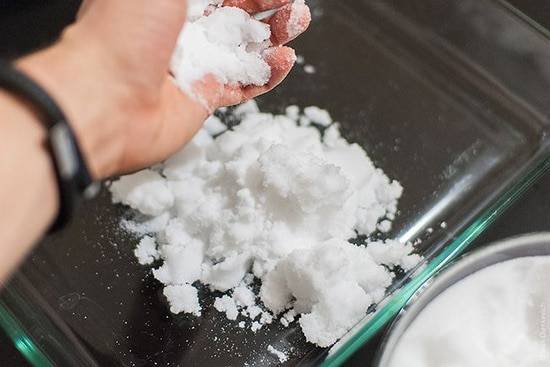
Soaking in soapy water
You can wash glassware from greasy scale with soapy water. Both detergent and laundry soap are good at removing carbon deposits and grease on enamel, ceramics, glass.
Pour hot water into a large bowl, add 1 tablespoon to 1 liter of detergent, or rub ½ bar of soap. Soak a baking sheet, leave for 2 hours or overnight. After soaking, you can easily wash the dishes.
Mustard Soak
The next opportunity to clean the baking sheet from carbon deposits with folk remedies is to wet it overnight in a mustard solution. Pour the powder onto a burnt baking sheet. Then pour hot water on top. In the morning, pour the mustard solution, wash and dry the baking sheet.
Cleaning with baking powder
You can also wash the glass baking sheet from greasy dirt using a baking powder. Put it in a bowl, add warm water. Do not overdo it, you should have a medium-thick gruel. Apply it with a napkin on a baking sheet, wipe thoroughly, leave to act for about 30-60 minutes. Clean the glass surface with a sponge and finally wipe with a damp cloth.
Methods for cleansing old fat
In order not to think about how to clean the oven from old soot, you do not need to let it go to a deplorable state.
After cooking, wipe the side panels and door from grease with a damp sponge. It is easier to clean the dirt while it is fresh than when it has cooled down.
Do not forget to wash the baking sheet after cooking. During heat treatment, food can burn on an uncleaned surface, soot settles on the walls of the oven. In addition to the unpleasant taste of the dish, carbon deposits on the stove, you will have to look for ways to get rid of the unpleasant odor in the apartment. If you notice signs of carbon build-up, use the tried and tested methods of cleaning the oven from old grease at home.
Vinegar + soda
Previously, there was no household chemicals that eat away at a thick ball of fat. The grandmothers used improvised means to clean the stoves. A mixture of vinegar and baking soda has worked well.
You can use each of the components separately, but the solution will give the result faster. Mix the substances in a 1: 2 ratio (vinegar - soda), with the resulting paste, process the walls of the oven, the glass on the door.
Thanks to the hydrogen formed as a result of the interaction, the burn is broken down in 40 minutes. It is easy to wash off the substance, using ordinary tap water.
Vinegar and soda are mixed until a homogeneous liquid, placed in the oven, bringing to a boil. When the product has cooled down, take it out and clean the walls of the oven with a damp sponge.
Ammonia
You can clean your oven from old carbon deposits with ammonia. To clean the coating from the inside, 200 ml of ammonia is poured into one container, and water into the other. The water is brought to a boil before placing in the oven.
The dishes are placed in the oven, turn it on for 5 minutes. Leave the oven to cool without removing the containers. When the stacks are cold, remove the dishes.
Using a hard sponge, wipe off the soot, carbon deposits, which will easily come off the walls and glass on the oven. The remaining ammonia is treated with a lattice, which is also exposed to soot.
Remember to open windows when using this cleaning method. The smell of ammonia is palpable, it causes dizziness and nausea.
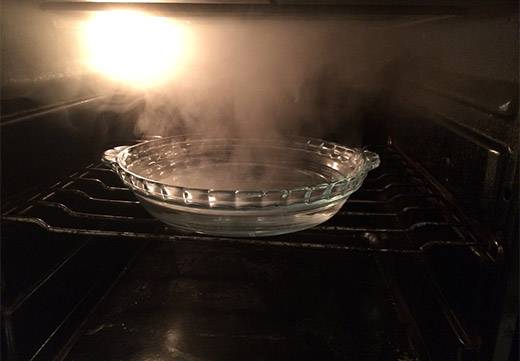
Laundry soap
The popular method of cleaning, which is still used today, is grated laundry soap. It consists of natural ingredients, does not cause allergic reactions on the hands, as happens when using household chemicals, thanks to the alkaline environment, it copes with dirt and grease. The cleaning procedure consists of the following stages:
- The soap is rubbed on a coarse grater.
- Mix with water.
- Placed in an oven and boil for 40 minutes.
- Allow the oven to cool down and rub it with a hard sponge, the fat will become porous and easily leave the walls and door.
- After removing the soap, rinse the walls with plain water.
It is recommended to open the door for a while so that the aroma of the master's soap evaporates and in the future does not distort the taste and aroma of dishes prepared in the oven.
Lemon
Lemon juice contains an acid that will eat away at the fat ball on the metal parts of the oven. The stove is processed with a slice of fresh lemon or, in its absence, citric acid (powder) is used. A positive result is obtained by squeezing the juice out of the lemon and mixing it with water. The liquid is applied to the frozen fat and left to dry for a couple of hours. Using a dart, remove soot and grease.
The second method consists in pouring acidified water into a spray bottle, so it is more convenient to apply, it will turn out to wipe off fat in hard-to-reach places.
You can soak the walls of the oven with citric acid by cutting the lemon into slices and sending it to a container of water.
The dish is placed in the oven and heated for 20 minutes. Leave the oven to cool without opening the door. Use a metal brush or a hard sponge to remove grease and burn residues.
Steam
The steam helps to clean the enamelled electric oven. The walls in such devices are fragile; when exposed to aggressive chemicals, their integrity can be violated.
As a result, the oven will overheat and the food will burn. You can remove carbon deposits by pouring water into a bowl, bringing it to a boil in the oven. For results, you can add a couple of drops of dish gel. No matter how thick the carbon layer on the walls and door is, hot steam will easily soften it, you can remove the excess with a damp cloth without additional friction.
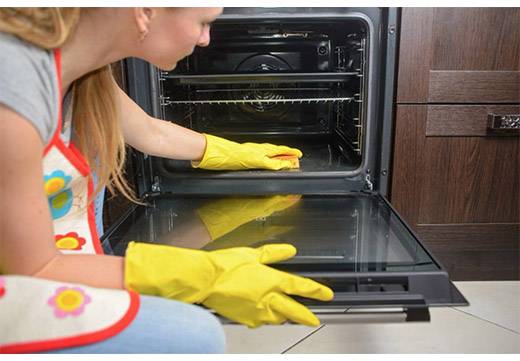
Cleaning Recommendations
If you are unsure how to clean a glass baking sheet, read this section first. We will tell you about the nuances that are not known to every housewife.
But first things first.
Cleaning a glass or ceramic baking sheet
Glass, ceramics, as well as enamel are fragile materials that are afraid of mechanical stress, temperature extremes and aggressive compounds. Most of the methods that are suitable in other cases cannot be applied here. How to remove carbon deposits?
Using soaking and mustard. Despite the seeming simplicity, the method is highly effective. When used correctly, mustard can remove fat from a baking sheet or pan in a matter of hours.
- Sprinkle mustard on the bottom of the leaf.
- Pour boiling water over and let everything soak overnight.
- Rinse off the grease with Fairy or Myth.
Rinse liberally and pat dry. Instead of mustard powder, you can use baking soda and salt mixed in a 1: 1 ratio.
We clean the aluminum baking sheet
The aluminum baking sheet can be cleaned with hydrogen peroxide, salt, mustard powder and boiling.The main thing is not to use vinegar and ammonia. If the remedies do not help, use the recipe.
- Sprinkle the salt on the sheet, in a layer of 5 mm.
- Preheat oven to 100 ° C.
- Place the baking sheet to heat the salt.
- As soon as it turns brown, take out the sheet and let it cool.
- Rinse with warm water.
The procedure can be repeated if necessary. Aluminum sheets can also be cleaned with dry soda, Pemolux powder and oven ash.
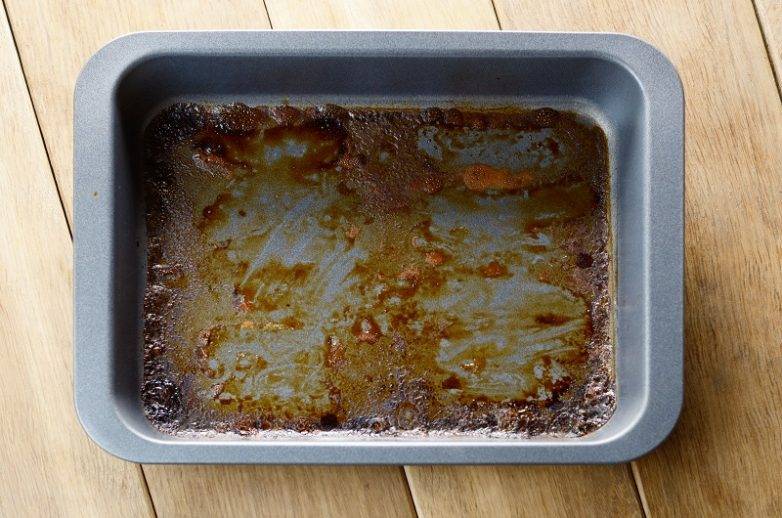
Silicone and Teflon trays
Silicone and Teflon baking sheets are very scrupulous in care, they are "afraid" of abrasives, caustic chemicals and alkalis. To remove carbon deposits, use a mild cleaning chemical that has a neutral medium.
Cleaning with Extra salt will also help.
- Use a wooden spatula to remove any pieces of fat and food.
- Add a layer of salt, wait half an hour.
- Pour 2-3 drops of neutral detergent and place a baking sheet or pan under the running water.
If it does not help, you can soak the dishes in warm water for 12 hours, then repeat the procedure.
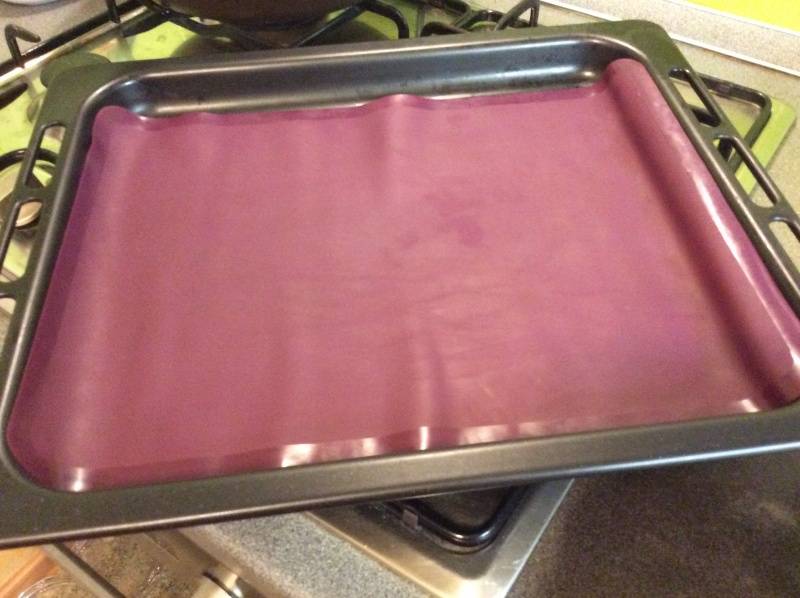
How to avoid carbon deposits
The best way to deal with carbon deposits is simply to keep them out. To do this, you need to follow simple rules:
- Use special parchment paper or foil when preparing food. It will be a kind of barrier that will protect your product from burnt fat.
- Wash the baking sheet immediately after cooking. There is no need to wait for several hours: dried fat and food particles will have to be wiped off for a long time. If you don't have time, simply add hot water and detergent to the baking sheet. After a while, you will be able to quickly put the product in order.
- The product you will use to clean any product, such as baking dishes, should not adversely affect the material. If you choose your products responsibly, your oven sheet will last much longer. It is also worth noting that the state of the baking sheet has a direct impact on the quality of the dishes.
Feel free to try new ways to clean up. Over time, you will find the most effective remedy. But never forget about your own health: do all the work with gloves.
Prevention of carbon deposits
With strict adherence to technology, carbon deposits will be minimal. To make it easier to put the container in order, they use parchment during baking: they cover the bottom with it, grease it. After cooking, there is only oil on the surface. Everything else is removed along with a layer of paper. Instead of a lid, use foil: cover the dish with it. Fat splashes less and does not settle on the outer walls.
It is better to wash off the remnants of food and fat immediately. If time does not allow, you need to soak the dishes in hot water with the addition of detergent. With a dried baking sheet, there are much more worries.
Dish cleaning experiments should be smart. If the protective layer is damaged, food can become dangerous, it will contain harmful components. It is better not to use abrasives at all. There are safe and affordable ways to wash your baking sheets.
Varieties of trays
Every home or professional kitchen is equipped with an oven, respectively, trays, which are used for roasting potatoes, meat, vegetables, buns, etc.
Today you can choose from a wide range of materials that are most suitable for preparing your favorite dishes:
- The most popular trays are made of stainless steel. They are produced both without a lid and with a lid, which simplifies the cooking process.
- Silicone trays can withstand temperatures up to 230 ° C in an oven or microwave, and won't be damaged even in the freezer. They can be baked without adding fat, the soft material makes it easier to remove the cooked dish. Silicone dishes are dishwasher safe.
- Teflon baking trays are suitable for quick baking.They offer good thermal conductivity to help save energy when baking. The non-stick coating allows you to cook food with a minimum amount of fat. Teflon baking trays are lightweight, not demanding to clean.
- Ceramic trays are ideal for slow baking and complex dishes. Excellent thermal conductivity ensures economical use. A minimum amount of fat can be used when cooking in ceramic pans.
- Glass trays are made of hard borosilicate glass, which is very resistant to mechanical stress and temperatures (+ 300–340 ºС). The advantage of glass is a long service life, hygienic harmlessness (smooth and non-porous surface), ease of maintenance - it can be washed in a dishwasher, environmental friendliness. Glass in general is one of the most desirable materials in the modern kitchen.
- Traditional enamelled baking trays are a guarantee of a long service life and ease of maintenance. They are dishwasher safe.
- Aluminum cookware is also a good choice. It is characterized by excellent thermal conductivity, light weight and, combined with a good non-stick coating, durability. It is better to choose cast aluminum products, not extruded, which are cheap, but mostly of poor quality.
